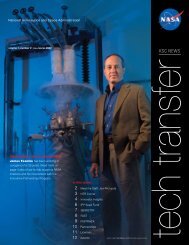2006-2007 - Kennedy Space Center Technology Transfer Office
2006-2007 - Kennedy Space Center Technology Transfer Office
2006-2007 - Kennedy Space Center Technology Transfer Office
- No tags were found...
You also want an ePaper? Increase the reach of your titles
YUMPU automatically turns print PDFs into web optimized ePapers that Google loves.
<strong>Space</strong>craft Electrostatic Radiation ShieldingThis project analyzed the feasibility of placing an electrostatic field around a spacecraft toFlightEnvironment provide a shield against radiation. The concept was originally proposed in the 1960s andMeasurement tested on a spacecraft by the Soviet Union in the 1970s. Such tests and analyses showedthat this concept is not only feasible but operational. The problem though is that most ofthis work was aimed at protection from 10- to 100-MeV radiation. We now appreciate that thereal problem is 1- to 2-GeV radiation. So, the question is one of scaling, in both energy and size.Can electrostatic shielding be made to work at these high energy levels and can it protect an entirevehicle?After significant analysis and consideration, an electrostatic shield configuration was proposed.The selected architecture was a torus, charged to a high negative voltage, surrounding the vehicle,and a set of positively charged spheres. Van de Graaff generators were proposed as the mechanismto move charge from the vehicle to the torus to generate the fields necessary to protect the spacecraft.This design minimized complexity, residual charge, and structural forces and resolved severalconcerns raised during the internal critical review. But, it still is not clear if such a system is costeffectiveor feasible, even though several studies have indicated usefulness for radiation protectionat energies lower than that of the galactic cosmic rays. Constructing such a system will requirepower supplies that can generate voltages 10 times that of the state of the art. Of more concernis the difficulty of maintaining the proper net charge on the entire structure and ensuring that itsinteraction with solar wind will not cause rapid discharge. Yet, if these concerns can be resolved,such a scheme may provide significant radiation shielding to future vehicles, without the excessiveweight or complexity of other active shielding techniques.Contact: Dr. Robert C. Youngquist , NASA-KSC, (321) 867-1829Participating Organization: ASRC Aerospace (Dr. John E. Lane and Irving E. Bushnell)“Spokes” house belts of large Van deGraaff generators.An equipotential electric-field surface at a far-field distance from theshield.118 Command, Control, and Monitoring Technologies













